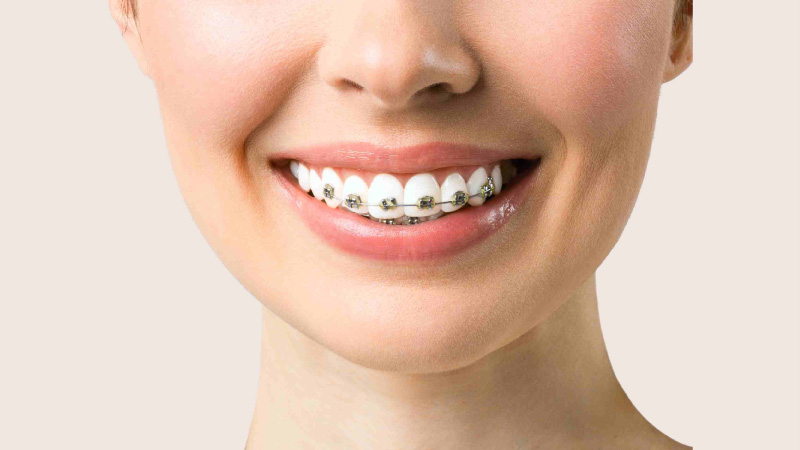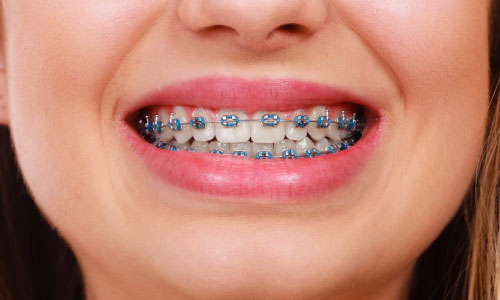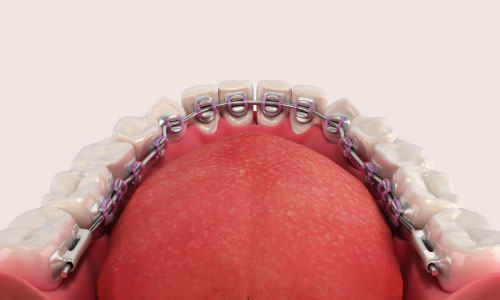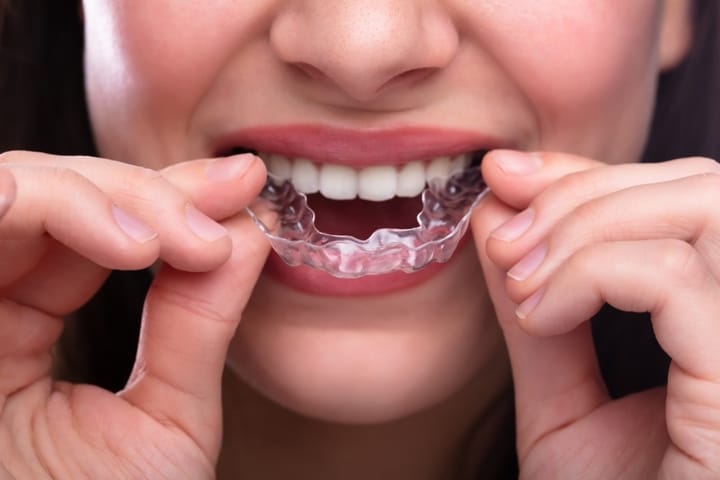Contents
- What are Orthodontic Braces?
- What Are the Different Types of Dental Braces?
- 1. Ceramic Braces: A Subtle Alternate
- 2. Self-Ligating Brackets: A Faster Way to Straight Teeth
- 3. Lingual Braces: Hidden Orthodontic Treatment
- 4. Clear Aligners: An Easier Way to Perfect Your Smile
- 5. Metal Braces: A Classic and Effective Choice
- On the contrary,

What are Orthodontic Braces?
Simply put, orthodontic braces are an orthodontic procedure that assists you in achieving a beautiful and straight smile by correcting the alignment of your teeth.
Braces employ metal brackets and wires to gradually shift your teeth into the proper position. Depending on what needs to be addressed, the entire process could take anywhere from 6 months to 2 years.
Regular appointments with an orthodontist will be required during this period to adjust the braces as needed and verify everything is going properly.
When wearing braces, it is critical to maintain appropriate oral hygiene for them to function properly.
Brushing after every meal, flossing once a day, and using fluoride mouthwash every night before bedtime are all part of it.
If any of the wires or brackets come loose or break during this period, you must see your orthodontist right away so that repairs can be made as quickly as possible.
Though the process of acquiring braces may appear frightening at first, there are numerous advantages to consider! A straighter smile looks nicer and helps to prevent cavities and other dental problems in the future.
It can even enhance confidence in people who were previously self-conscious about their crooked teeth! If you desire nothing more than a beautiful, healthy smile, look into orthodontic braces!
But, before you consider having braces to improve your ideal smile, consider the several alternatives available in orthodontic braces and how each one works and contributes to achieving the smile you've always desired.
Everyone wants that million-dollar smile, but it can be very complicated and intimidating with so many alternatives on the market and so much information on the internet about how braces work and which ones are bad.
We have compiled a list of orthodontic braces and their applications. Continue reading!
What Are the Different Types of Dental Braces?
When you think of braces, it’s natural to imagine metallic clips and stringy wires but there’s a lot more where that came from.
Not all teeth braces feel like cages and there are different types of dental braces to suit unique dental needs.
1. Ceramic Braces: A Subtle Alternate
If braces are your only option and you want to straighten your teeth without bringing attention to yourself, ceramic braces may be the clear decision for you!
This form of ortho brace is also referred to as an "invisible" or "transparent" brace. This is because it is a brace with ceramic brackets composed of composite materials that are the same colour as your teeth.
This blends in with your natural grin, providing an aesthetically acceptable appearance while allowing you to receive orthodontic therapy.

Here are the top 5 advantages of ceramic braces:
- Because they are composed of porcelain, these brackets have very little likelihood of corroding or creating irritation.
- When compared to other metal rivals, they require minor changes.
- Because of their translucent hue, they are speedier than regular braces and nearly unnoticeable.
- These braces necessitate few medical visits and appointments.
- Ceramic brace systems can also be expected to endure longer than other types of braces due to their sturdy design and lack of corrosion potential that metals can encounter over time!
2. Self-Ligating Brackets: A Faster Way to Straight Teeth
Self-ligating brackets are another rapid and effective solution for tooth straightening. This novel method of teeth straightening has been used for centuries, although it has only recently acquired popularity.
They are currently the most popular alternative among other braces and one of the most progressive braces. What an irony!
The brackets themselves hold the wire in place using self-ligating braces, eliminating the need for additional ties or elastic bands.
Because there is no need to add more components during each appointment, treatment is more efficient and less time-consuming.

Furthermore, because they are not subjected to the pressure of tightened elastics, patients can have a more comfortable experience with this technique.
Self-ligating brace systems are classified into two categories.
Braces that passively self-ligate
This makes use of a smaller archwire, resulting in less friction. Because the patient is not acclimated to greater pressures, most orthodontists use a passive appliance at the start of therapy.
Braces that actively self-ligate
Many orthodontists prefer this after the initial round of therapy. Active self-ligating brackets use a larger archwire that exerts greater force than passive brackets, causing the teeth to move more quickly.
Finally, self-ligating brackets have the advantage of allowing both the patient and the clinician to easily evaluate progress during therapy.
This allows orthodontists to make any necessary modifications while simultaneously screening for signs of decay or gum disease.
3. Lingual Braces: Hidden Orthodontic Treatment
Let's just call this type of brace the shyer brother of regular braces. This is because lingual braces are identical to tractional braces except that they are placed on the back of your teeth.
As a result, they give a wonderful aesthetic choice for people who want to straighten their teeth without wearing braces.
They provide many of the same advantages as traditional braces, but they are virtually invisible while worn, making them suitable for adults and teenagers who wish to straighten their teeth without bringing attention to them.

Lingual braces employ special brackets that connect to the backs of your teeth rather than the fronts, so you won't be able to tell you're wearing them.
The lingual braces procedure begins with an impression or digital scan of your teeth, which is utilised to construct custom-made brackets just for you. The brackets are then attached to your natural tooth structure with strong glue.
Your orthodontist will next thread a small wire through each bracket and make any changes necessary to obtain the desired results.
Depending on the severity of the misalignment in your mouth, the full process normally takes 6-12 months.
Once you've removed your lingual braces, it's critical to maintain frequent follow-up visits with your dentist or orthodontist to ensure that all of your progress is preserved over time.
In addition, after having your retainers removed, you should wear them at night.
All in all, lingual braces provide an effective solution for those looking for discreet orthodontic treatment without sacrificing quality results!
4. Clear Aligners: An Easier Way to Perfect Your Smile
Wait till you meet Dezy and everything we come up with if you thought that famous brand was the only one providing you with the greatest clear aligners!
Clear aligners are one of the most inconspicuous teeth-straightening options available today. These translucent, plastic aligners fit securely over your teeth and may be removed for eating and cleaning.

Clear aligners are a popular option for people who wish to improve their smile without drawing attention to the fact that they are undergoing orthodontic treatment.
The aligner is custom-made for each patient's needs utilising 3D imaging technology. They gently push your teeth into the proper position, giving you a straighter smile in less time than traditional braces.
Clear aligners, unlike traditional metal braces, are nearly invisible and do not require adhesives or brackets, making them more comfortable to wear.
They can also be removed during meals or snacks, allowing you to continue eating the items you prefer while undergoing treatment.
Because the material used to produce clear aligners is transparent, you can freely smile during your treatment without worrying about how it will appear on camera or in person!
Clear aligner treatments often take less time than traditional braces and are less expensive than other cosmetic dental procedures like veneers or crowns.
The best aspect about choosing a discrete teeth straightening option like transparent aligners is that no uncomfortable adjustments are required!
Clear Aligner treatments entail the gradual shifting of your teeth into their desired positions over time, resulting in fewer visits to the dentist's office and greater overall convenience.
Furthermore, because these clear trays do not interfere with chatting or sipping hot beverages, there is no disruption in everyday activities!
Because transparent aligners are both comfortable and effective, they are an excellent solution if you want to improve your smile discreetly while maintaining your natural teeth.
5. Metal Braces: A Classic and Effective Choice
This is for the old school!
Metal braces are a traditional and successful option for straightening teeth and correcting misalignments.
They've been there for decades, and while they're not the most cutting-edge or glamorous, they're still one of the most dependable orthodontic treatment options.

- Metal braces use stainless steel brackets that are connected to each tooth with dental adhesive or cement. An archwire is then inserted through the brackets and secured with elastic bands to gradually shift the teeth into place.
- Metal braces can treat a variety of disorders, such as reducing gaps between teeth, realigning crooked teeth, and correcting an overbite.
- Metal braces are advantageous in that they are both robust and flexible.
- Because metal braces apply moderate pressure on your teeth over time, results are usually noticeable within 6 months, depending on the severity of the misalignment or other irregularities being corrected.
- Metal braces are also among the least expensive types of braces treatment available today, making them affordable to anybody in need.
On the contrary,
It is critical to see your orthodontist before deciding on your favourite braces and finalizing them. This is where Dezy enters the picture.
You can schedule a consultation from the comfort of your own home or the location from which you are reading this article!
Our experts will come to your home and do a comprehensive scan of your mouth before giving you an estimate of your treatment process.
Once you are satisfied with the consultation, you will have taken the first step towards achieving your ideal smile!
Following that, the aligner would be delivered to your home, or you might attend the local Dezy facility for your operation. Why not do a free smile evaluation right now and see for yourself?


